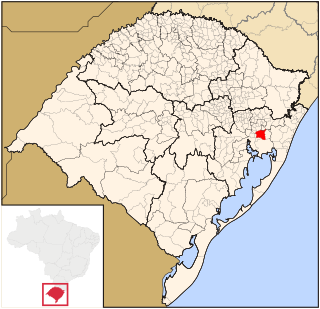
Porto Alegre is the capital and largest city of the Brazilian state of Rio Grande do Sul. Its population of 1,488,252 inhabitants (2020) makes it the 12th-most populous city in the country and the center of Brazil's fifth-largest metropolitan area, with 4,405,760 inhabitants (2010). The city is the southernmost capital city of a Brazilian state.

Rio Grande do Sul is a state in the southern region of Brazil. It is the fifth-most populous state and the ninth-largest by area. Located in the southernmost part of the country, Rio Grande do Sul is bordered clockwise by Santa Catarina to the north and northeast, the Atlantic Ocean to the east, the Uruguayan departments of Rocha, Treinta y Tres, Cerro Largo, Rivera, and Artigas to the south and southwest, and the Argentine provinces of Corrientes and Misiones to the west and northwest. The capital and largest city is Porto Alegre. The state has the highest life expectancy in Brazil, and the crime rate is relatively low compared to the Brazilian national average. Despite the high standard of living, unemployment is still high in the state, as of 2017. The state has 5.4% of the Brazilian population and it is responsible for 6.6% of the Brazilian GDP.

Novo Hamburgo is a municipality in the southernmost Brazilian state of Rio Grande do Sul, located in the metropolitan area of Porto Alegre, the state capital. As of 2020, its population was 247,032. The city covers an area of 217 km2 (84 sq mi), and the average temperature is 19 °C (66 °F), which is mild for the region. The Sinos River runs through the urban area.

The Ragamuffin War or Ragamuffin Revolution was a Republican uprising that began in southern Brazil, in the province of Rio Grande do Sul in 1835. The rebels were led by generals Bento Gonçalves da Silva and Antônio de Sousa Neto with the support of the Italian fighter Giuseppe Garibaldi. The war ended with an agreement between the two sides known as Green Poncho Treaty in 1845.

Santa Maria is a municipality (município) in the central region of Rio Grande do Sul, the southernmost state of Brazil. In 2020, its population was 283,677 inhabitants in a total area of 1,823 square kilometres (704 sq mi). Santa Maria is the 5th biggest municipality in the state, and the largest in its micro-region.

The Campeonato Gaúcho, officially named as Campeonato Gaúcho de Futebol Série A and commonly known as the Gauchão or the Gauchão Ipiranga for sponsorship reasons, is the state football league of the Brazilian state of Rio Grande do Sul. It has been contested since its founding in 1919, being an amateur competition until 1940 when the league became professional. Twelve teams contest in the Campeonato Gaúcho, typically from January to April, for the state championship title.

Gravataí is a Brazilian municipality near Porto Alegre at the Rio Grande do Sul State. Its population is approximately 280,000 people, making it the sixth most populous city in the state.

Canoas is a municipality in the state of Rio Grande do Sul, Brazil, forming part of the of the Greater Porto Alegre area. Officially declared a city on June 27, 1939, after its separation from São Sebastião do Caí and Gravataí, Canoas derives its name from the historical crafting of canoes in the area. It is the second largest city in the Porto Alegre metropolitan area, with the third-largest population and the third-highest GDP in the state. It is also ranked as the 79th most populous city in Brazil.

Guaíba is a city located in the Metropolitan Porto Alegre of Porto Alegre, in the Brazilian state of Rio Grande do Sul. The city is on the shores of the Guaíba Lake.

Alvorada is a municipality in the state of Rio Grande do Sul, in the south of Brazil, adjacent to the capital of the state, Porto Alegre. The city is also known as "The Capital of Solidarity." Alvorada is primarily a bedroom community with most workers commuting to adjacent cities such as Porto Alegre to work. Its name means "the awakening" or "the sunrise".

Campo Bom is a town located in the valley of the Sinos River, in the State of Rio Grande do Sul, Brazil. It belongs to the Greater Porto Alegre area.

Tapes is a municipality in Rio Grande do Sul state, Brazil, near to Porto Alegre. It is good for sailing, windsurfing, kitesurfing. Tapes
The government of Porto Alegre, bound to the Porto Alegre City Charter, is a mayor-council form of government, which is mandated by the Brazilian Constitution of 1988. The government of Porto Alegre is responsible for primary education, healthcare, libraries, parks and open spaces, sanitation, water supply, and youth correctional services.

The Campeonato Gaúcho Série A2 are the football tournament for the Rio Grande do Sul clubs that do not play in the Campeonato Gaúcho Série A1 in Brazil. The competitions are organized by the Rio Grande do Sul Football Federation. Usually, the champions of a division are promoted in the next year to the immediately upper level.

Maria do Rosário Nunes is a Brazilian teacher and politician. She graduated in pedagogy from the Federal University of Rio Grande do Sul, and took a postgraduate degree at the University of São Paulo. From 2011 to 2014, she served as the Secretary for Human Rights under the Rousseff administration. With the exception of her three-year tenure as Human Rights Secretary, she has been a congresswoman since 2003, representing the southern Brazilian state of Rio Grande do Sul as a member of the Worker's Party (Brazil).

Esporte Clube Cruzeiro, commonly referred to as Cruzeiro-RS, is a Brazilian football club based in Cachoeirinha, Rio Grande do Sul. It currently plays in Campeonato Gaúcho Série A2, the second level of the Rio Grande do Sul state football league.

Aldyr Garcia Schlee was a Brazilian writer, journalist, translator, illustrator, and professor.
The following is a timeline of the history of the city of Porto Alegre, in the state of Rio Grande do Sul, Brazil.

The history of Rio Grande do Sul begins with the arrival of Man in the region, around 12,000 years ago. Its most dramatic changes, however, occurred in the last five centuries, after the discovery of Brazil. This most recent period took place amid several external and internal armed conflicts, some of which with great violence.

African Culture in Rio Grande do Sul refers to the history, attributes, and values of African-Brazilian culture in the Brazilian state of Rio Grande do Sul.























